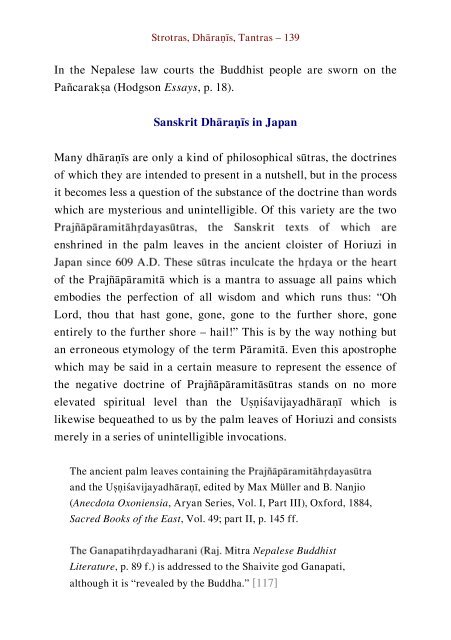Literary History of Sanskrit Buddhism
A study by J. K. Nariman of Sanskrit Buddhism from the Early Buddhist Tradition up to the Mahayana texts proper.
A study by J. K. Nariman of Sanskrit Buddhism from the Early Buddhist Tradition up to the Mahayana texts proper.
Create successful ePaper yourself
Turn your PDF publications into a flip-book with our unique Google optimized e-Paper software.
Strotras, Dhāraṇīs, Tantras – 139<br />
In the Nepalese law courts the Buddhist people are sworn on the<br />
Pañcarakṣa (Hodgson Essays, p. 18).<br />
<strong>Sanskrit</strong> Dhāraṇīs in Japan<br />
Many dhāraṇīs are only a kind <strong>of</strong> philosophical sūtras, the doctrines<br />
<strong>of</strong> which they are intended to present in a nutshell, but in the process<br />
it becomes less a question <strong>of</strong> the substance <strong>of</strong> the doctrine than words<br />
which are mysterious and unintelligible. Of this variety are the two<br />
enshrined in the palm leaves in the ancient cloister <strong>of</strong> Horiuzi in<br />
<strong>of</strong> the Prajñāpāramitā which is a mantra to assuage all pains which<br />
embodies the perfection <strong>of</strong> all wisdom and which runs thus: “Oh<br />
Lord, thou that hast gone, gone, gone to the further shore, gone<br />
entirely to the further shore – hail!” This is by the way nothing but<br />
an erroneous etymology <strong>of</strong> the term Pāramitā. Even this apostrophe<br />
which may be said in a certain measure to represent the essence <strong>of</strong><br />
the negative doctrine <strong>of</strong> Prajñāpāramitāsūtras stands on no more<br />
elevated spiritual level than the Uṣṇiśavijayadhāraṇī which is<br />
likewise bequeathed to us by the palm leaves <strong>of</strong> Horiuzi and consists<br />
merely in a series <strong>of</strong> unintelligible invocations.<br />
The ancient palm leaves containin<br />
and the Uṣṇiśavijayadhāraṇī, edited by Max Müller and B. Nanjio<br />
(Anecdota Oxoniensia, Aryan Series, Vol. I, Part III), Oxford, 1884,<br />
Sacred Books <strong>of</strong> the East, Vol. 49; part II, p. 145 ff.<br />
tra Nepalese Buddhist<br />
Literature, p. 89 f.) is addressed to the Shaivite god Ganapati,<br />
although it is “revealed by the Buddha.” [117]


















